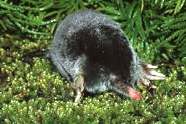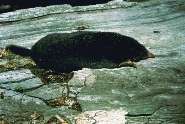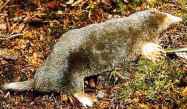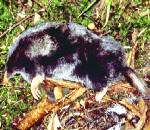9870 St Vincent Place, Glasgow, DC 45 Fr 45.
Волосатохвостые кроты

- Отряд: Insectivora Bowdich, 1821 = Насекомоядные
- Семейство: Talpidae Fischer von Waldheim, 1817 = Кротовые
- Род: Parascalops True, 1894 = Волосатохвостые кроты
- Вид: Parascalops breweriBachman = Волосатохвостый крот
Род волосатохвостых кротов = Parascalops True, 1894
Волосатохвостый крот - Parascalops breweri Bachman, 1842

Размеры средние. Длина тела 11-14 см. Длина хвоста приме рно 2-3,6 см. Вес взрослых 40-55 г. Внешний вид напоминает представителей рода кротов. Однако голова сильнее вытянув в лицевом. Первая пара верхних резцов крупнее остальных зубов и имеет долотообразую форму. В скелете конечностей ключица развита относительно слабо, а плечевая кость очень сильно. Таз узкий. Костное соединение крестцовых позвонков с седалищными костями отсутствует.

Обитатель лесов и открытых мест. Предпочитает легкие, хорошо дренированные почвы. Распространен от уровня моря до примерно 900 м над уровнем моря. Норы имеют сложную систему, обычную для кротов. Гнездовую камеру диаметром около 15 см. устраивает на глубине 25—30 см. Зимняя гнездовая камера помещается несколько глужбе, выстилается листьями и травой. Иногда кроты используют одни и те же норы в течение ряда лет. Активность круглосуточная. Ночью иногда передвигаются по поверхности земли. Питаются земляными червями, насекомыми и другими беспозвоночными. Период спаривания приходится на март — апрель. Беременность 4—6 недель. В помете от 4 до 5 детенышей.
Распространен в юго-восточной Канаде и северо-восточных районах США.

Geographic Range
Hairy-tailed moles are found from southern Quebec and Ontario to central Ohio, and south as far as western North Carolina in the Appalachian Mountains (Walker, 1964). In 1995 a hairy-tailed mole was observed near the north end of Agawa Bay in Lake Superior Provincial Park. This is approximately 45km north of the previous peripheral record of Pancake Bay, Ontario (Hecnar, 1996).
Hairy-tailed moles are found mainly in secondary growth hardwood forests, edge habitats, and meadows, with soils that are light and well drained (Hecnar, 1996). The elevation range is from sea level to about 900 meters (Walker, 1964).
Physical Description:Mass 40 to 85 g; avg. 62.50 g (1.41 to 2.99 oz; avg. 2.2 oz) Length: 116 to 140 mm; avg. 128 mm (4.57 to 5.51 in; avg. 5.04 in)
Hairy-tailed moles can be distinguished from other moles that are in Ontario by their short snout, hairy tail, and lack of protuberances on the snout (Hecnar, 1996). The length of the head and body is 116 to 140 mm, and the length of the tail is 23 to 36 mm. Adults weigh from 40 to 85 grams. The fur is thick, and soft, but it is slightly coarser than in the eastern American mole (Scalopus). The color is blackish . White spots are often present on the breast or abdomen; the snout, tail, and feet may become almost pure white with age. The snout is shorter than in Scalopus or Scapanus and has a median longitudinal groove on the anterior half. The nostrils are lateral and directed upward. There are no external ears, and the eyes are nearly hidden by the fur. The palms of the hands are as broad as they are long, and the digits are not webbed. The tail is thick and fleshy, with a constriction at the base. The tail is also annulated with scales, and covered with long hairs. Females have four pairs of mammae (Walker, 1964). Sexual dimorphism is evident with males being slighly larger than females (Hallett, 1978).
Reproduction: The mating system and behavior of this species has not been characterized.
These moles mate in March or April. Testes reach their maximum size in March then decrease sharply in mid-May. The testes reach their resting size in October. Females produce one litter per year and become reproductive at 10 months. The usual litter size is four or five. Estimated gestation time is four to six weeks (Hallett ,1978).
Although parental care in this species has not been characterized, females are known to care for and nurse their young. Nestling moles are whitish, wrinkled, and naked except for short whiskers on the snout and facial hairs near the eyes and on the lips. The postnatal pelage is slightly grayer and much shorter than that of adults in summer (Hallett ,1978).
Hairy-tailed moles live an average of 3 years in the wild. They live 3-4 years in captivity. (The Wildlife Fact File, 1991)
Behavior: Hairy-tailed moles are primarily fossorial (Hallett, 1978). They push up surface ridges of soil from shallow subsurface tunnels and mounds of earth through a vertical passage from deep tunnels. P. breweri appears to be most active during the day. These moles are solitary in the winter. They travel on the surface of the ground at night (Walker, 1964).
Moles of both sexes winter seperately. Males freely associate during spring, and by late summer males, females, and young all utilize the same tunnel systems. After mating, females once again become solitary and construct nests. Hairy-tailed moles use underground tunnels that they dig as a passageways (Hallett,1978).
Food Habits: Hairy-tailed moles are insectivores. Their diet consists mainly of earthworms, ants, beetle larvae, centipedes, and small rootlets. Ants may be an important food item when other foods are scarce. These moles starve when only vegetable matter is offered (Hallett, 1978).
Plant Foods: roots and tubers.
Predation: Known predators: Red fox, Opossum, Cat, Dog, Gray owl, Barn Owl, Copperhead Snake
Bullfrog: Hairy-tailed moles travel on the surface of the ground at night and are sometimes captured by owls or other animals (Walker, 1964). Other known predators include red fox, opossum, cats, dogs, gray owl, barn owl, copperhead snake, and an adult mole was taken from the stomach of a bullfrog (Hallett,1978). There are no reports in the literature on any anti-predator adaptations in this species.
Ecosystem Roles: Because these are tunneling mammals, hairy-tailed moles assist in aeration of soil. They also likely play a role in regulating populations of invertebrates upon which they feed.
Hairy-tailed moles are probably economically neutral due to the species' local distribution, doing some damage to lawns, gardens, and golf courses (Hallett ,1978).
Hairy-tailed moles house certain endoparasites: Acanthocephalid worms are fequently found in the intestine, roundworms are found in the stomachs of some of the moles, fleas and mites are the most numerous ectoparasites, occurring in the greatest abundance in the spring and summer. The louse, Euhaematopinus abnormis and the beetle, Leptinus americanus have been found on some specimens (Hallett, 1978).
http://animaldiversity.ummz.umich.edu/site/
